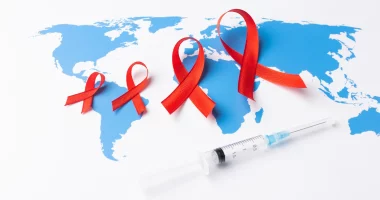Achalasia is a condition that affects the esophagus, also known as the food pipe. It causes the muscles and cells in the esophagus to stop working properly. This can make swallowing difficult, cause chest pain, and lead to food coming back up (regurgitation).
Achalasia can also affect other parts of the digestive system, like the intestines. Hirschsprung’s disease is a specific form of achalasia.
Most people are diagnosed with achalasia between the ages of 25 and 60. As stated by the American Journal of Gastroenterology, about 1 in 100,000 people have this condition, and it affects men and women equally.
The cause of achalasia is unknown to healthcare providers, and there is no cure yet. However, treatments are available to help manage and reduce the symptoms.
What is Achalasia?
Achalasia is a long-term condition that affects the esophagus, causing the nerves to gradually stop working properly.
The tube that links between your throat and stomach, running between your windpipe and spine is known as esophagus. It continues down from your neck to join the upper part of your stomach.
Normally, when you swallow, the muscles in the walls of your esophagus contract and push food particles or liquid into your stomach. The esophagus also produces mucus to help this process.
In achalasia, the lower part of the esophagus doesn’t open properly to let food pass through. This happens because the smooth muscle in this area is weak.
When the smooth muscle can’t move food downward, it’s termed as aperistalsis of the esophagus.
Doctors don’t know exactly what causes achalasia, but recent research from the Society of Thoracic Surgeons suggests it might be an autoimmune disease, where the immune system targets nerve cells in the muscles of the esophagus.
In South America, a parasite that causes Chagas disease can also reason to the kinds of achalasia.
This condition is not inherited and affects people of all ethnic backgrounds equally.
Common symptoms
Symptoms of achalasia typically manifest gradually, initially presenting as mild inconveniences that can easily be dismissed. However, as the condition progresses, individuals may experience escalating challenges in swallowing liquids and food.
Common symptoms include:
Dysphagia
Food swallowing difficulties, often starting as occasional discomfort but worsening over time.
Regurgitation
Experiencing the back up of liquid and food after swallowing, which can be bothersome and unpleasant.
Coughing
Particularly noticeable when lying down, coughing episodes may occur due to the regurgitation of food and liquid.
Chest Pain
Resembling heartburn, this discomfort may be mistaken for a heart attack, causing considerable distress.
Respiratory Issues
Inhaling food, liquid, or saliva into the lungs while swallowing can lead to breathing difficulties.
Weight Loss
As swallowing becomes increasingly challenging, individuals may unintentionally lose weight due to decreased food intake.
Difficulty Burping
Burping may become difficult or infrequent, contributing to feelings of discomfort.
Sensation of a Lump in the Throat
Individuals may perceive a persistent sensation of having something stuck in their throat, further complicating swallowing.
To cope with these symptoms, individuals may adopt compensatory behaviors such as eating more slowly, adjusting their neck position, or altering their posture to facilitate swallowing. However, despite these efforts, symptoms typically worsen over time, highlighting the progressive nature of achalasia.
Diagnosis
Diagnosing achalasia can be tricky because its symptoms are similar to those of other conditions like gastroesophageal reflux disease (GERD) or hiatus hernia. This similarity makes it hard for healthcare providers to figure out what’s going on.
To help make the right diagnosis, the doctor might suggest some tests to rule out other problems:
X-ray and barium swallow test
In this test, the person drinks a white liquid called barium sulfate. Barium shows up clearly on X-rays. As the person swallows the barium, it coats the esophagus, making it visible on X-ray images. This helps the doctor see if there are any abnormalities in the esophagus.
Esophageal manometry
This test measures the movements and pressure of muscles in the esophagus. A specialist, called a gastroenterologist, inserts a thin tube called a manometer through the person’s nose. The person then swallows several times while the doctor watches how their muscles are working. This test helps the doctor see if the muscles in the esophagus are functioning properly and if the lower esophageal sphincter relaxes properly during swallowing. It can also rule out cancer.
Endoscopy
During this process, a physician employs a tiny camera affixed to a thin tube to examine the interior of both the esophagus and stomach.. The person is usually sedated during this test. Endoscopy can help the doctor see if there are any symptoms of achalasia, inflammation, ulcers, or tumors that might be causing indicators. Sometimes, the doctor may take a small sample of tissue, called a biopsy, to check for cancer under a microscope in a lab.
Treatment
Treatment for achalasia doesn’t completely cure the condition or restore full nerve function. However, there are ways to lessen the seriousness of symptoms:
Medications
In the early stages of the condition, medications may be used to relax the narrowed part of the esophagus, allowing food to pass through more easily. Examples include nitrates and calcium channel blockers. However, these medications may lose effectiveness over time.
Pneumatic balloon dilation
This procedure involves inflating a balloon to enlarge the narrowed area in the lower esophageal sphincter. It’s effective in relieving symptoms for almost 70% of patients but may need to be repeated. Complications can include chest pain and a small risk of perforating the esophagus.
Myotomy
Surgery to cut the muscles in the lower esophagus can prevent obstruction. Success rates range from 60–94%, but up to 31% of patients may grow GERD afterward, depending on the kind of procedure.
Peroral endoscopic myotomy (POEM)
A recently developed technique in which a surgeon utilizes an electric scalpel passed through an endoscope to carve out a tunnel within the lining of the esophagus. It’s considered effective and safe, but long-term effects are still being studied.
Botox injections
Botulinum toxin injections can relieve the muscles at the lower part of the esophagus. This option is suitable for those who can’t undergo surgery. It gives relief for about 50% of pateints for up to 6 months but may require repeat injections
After these procedures, recovery times vary. Noninvasive procedures usually require 24–48 hours in the hospital and come back to usual activities in just 2 weeks. Open surgery may necessitate a longer hospital stay but allows for a return to an actual lifestyle within 2–4 weeks.
To manage acid reflux, a doctor may prescribe proton pump inhibitors (PPIs) after surgery or certain procedures. These medications help reduce acid levels in the digestive system, lowering the risk of acid reflux.
Complications
Complications of achalasia can be serious, so it’s important for people with this condition to have regular check-ups to catch any issues early.
Some possible complications include:
- Acid reflux: This can lead to heartburn and damage to the esophagus over time.
- Esophageal enlargement: In some cases, the esophagus can become severely enlarged, making it difficult for food to pass through.
- Esophageal cancer: There is a small risk of developing squamous cell esophageal cancer, although regular screening for this is not generally recommended.
The American College of Gastroenterology does not suggest regular examinations for esophageal cancer through endoscopy, as it’s not clear if this reduces the risk of cancer. However, some doctors may suggested screening every 3 years for those who had achalasia for 10–15 years. This screening is more useful for detecting complications like an enlarged esophagus (megaesophagus) rather than cancer.
If complications like megaesophagus or esophageal cancer are detected, surgery to remove the esophagus may be necessary. However, early spotting and treatment can often prevent this from being needed.
Diet
After treatment, a person with achalasia will likely start with a liquid diet for a few days. As swallowing gets easier, they can switch to eating solid foods.
It’s important for people with achalasia to eat slowly, chew their food well, and drink lots of water while consuming meals. They should also avoid eating right before bedtime.
Sleeping with the head raised slightly can help food move through the esophagus more easily and reduce the chances of regurgitation.
Certain foods can make symptoms worse, so it’s best to avoid them. These include:
- Citrus fruits
- Caffeine
- Ketchup
- Chocolate
- Alcohol
These foods can increase reflux, which is when stomach acid flows back up into the esophagus. Foods that are fried or spicy can also cause irritation in the digestive system and worsen symptoms.
While there’s no specific diet for achalasia, a 2017 review recommends that eating a low-fiber diet could help by reducing the bulk of food, making it easier to swallow.
Outlook
Although there’s still a lot for researchers to understand about achalasia, most people experience long-term improvement in their symptoms after treatment, according to the Genetic and Rare Diseases Information Center. About 90% of people see this improvement.
In some cases, surgery might be needed to clear the entire esophagus. This happens to about 10-15% of individuals.
If someone starts having trouble swallowing, it’s important for them to see a doctor as soon as possible. Getting early treatment can improve their outlook and help manage the condition better.








